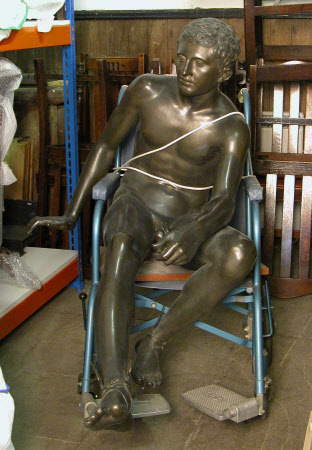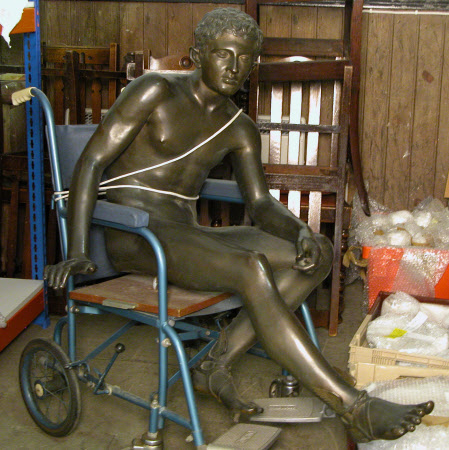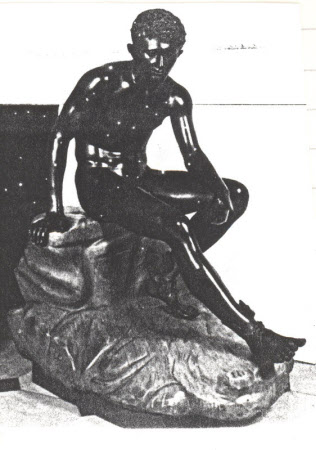The god Mercury seated
attributed to Sabatino de Angelis (b.1838)
Category
Art / Sculpture
Date
c. 1889 - 1890
Materials
Bronze on a dove grey marble base
Measurements
1220 x 610 mm (48 x 24 in)
Place of origin
Naples
Order this imageCollection
Hatchlands Park, Surrey
NT 1166745
Summary
Sculpture, bronze; figure of the god Mercury, seated; after a Greco-Roman original, Naples, probably foundry of Sabatino de Angelis; c.1889-90. A bronze figure of a young man, his sandals equipped with small wings helping to identify him as Mercury, the god of speed, commerce and travellers. A full-size cast, probably made in the Neapolitan foundry of Sabatino de Angelis (1838- c. 1915), of a Roman bronze figure discovered at Herculaneum in 1759 and today in the collections of the Museo Archeologico Nazionale in Naples. The figure is now missing the large rocky base on which it would originally have been placed. Sabatino de Angelis was one of the best of a number of Neapolitan sculptors in the later nineteenth and early twentieth centuries, who set up bronze foundries to meet the demand for copies of famous antiquities, especially but not just those being discovered in Pompeii and Herculaneum. The group of five bronze casts at Hatchlands is an impressive representative example of this fashion in the decades around 1900.
Full description
A full-size bronze copy of a bronze figure found at the Villa dei Papiri in Herculaneum in 1758. Mercury (Greek Hermes), the classical god of speed, commerce and travellers, is depicted as a naked young man, identifiable as Mercury by the winged sandals that he wears. He is seated, looking pensively down towards his right. The copy at Hatchlands was formerly seated on a large rocky mound, on which his right hand would have rested. The rocky base is now missing, whilst at least one of the wings from Mercury’s sandals has become detached. The seated figure of Mercury (Hermes) is one of a number of exceptional bronze sculptures that were discovered at the so-called Villa dei Papiri in Herculaneum, during excavations undertaken between 1754-58 for Charles VII, King of Naples and Sicily (1716-1788; from 1759 King Charles III of Spain), under the direction of the Swiss military engineer Karl Weber (1712-1764). The Villa dei Papiri was a luxurious residence built at the edge of the sea in the Roman city of Herculaneum. Like its neighbour Pompeii, Herculaneum was entirely buried in volcanic ash following the eruption of Mount Vesuvius in A.D. 79 and was subsequently lost to the world until excavations from the mid-eighteenth century. The Mercury, ; Naples 1989, II, pp. 126-27, no. 156; Lapatin 2019, p. 20, fig. 4.3), was originally situated in the villa’s grand peristyle, near the western end of the fishpond at its centre. The sculpture, which today is in the Museo Archaeogico Nazionale in Naples (Inv. 5625), is regarded by modern scholars as a Roman copy, from c. 100 BC – 79 AD, of a lost Greek bronze made in around 340-310 BC. It has not been possible to examine in detail this sculpture, which is currently in storage and is also missing the mound upon which it should be mounted. (Note: the mound was missing at time of inspection but has since been found, so could be reunited with the statue in future. MSH 18/03/2024) But as part of the impressive group of the foundry's works at Hatchlands, it is very likely to be a product of the Sabatino de Angelis foundry and may well be signed and dated, like other sculptures in this group of casts at Hatchlands, made after ancient sculptures in Naples. The foundry operated in Naples by Sabatino de Angelis (1838 – c. 1915) was established in 1840, presumably by Sabatino's father. Sabatino de Angelis and Son became, along with the Chiurazzi and Giorgio Sommer, one of the most successful and best-known of the Neapolitan foundries, capitalising on the huge international demand in the later nineteenth century for high-quality copies of antiquities from Herculaneum, Pompeii, Rome and elsewhere. This demand grew exponentially after the Italian government agreed in 1860 to allow the making of copies of objects in the museum in Naples. All three foundries published catalogues of the products they offered, the 1900 catalogue from Sabatino de Angelis proudly proclaiming on its cover that the firm supplied casts to various European royal houses, as well as leading museums in London, Edinburgh, Glasgow, Boston, Chicago, New York and elsewhere. In the 1870s, Sabatino de Angelis also entered into a joint venture with the rival Chiurazzi foundry, forming the Fonderie Artistiche Riunite, the main purpose of which was to cater for the burgeoning American market. It also published a catalogue in 1910, largely based on the 1900 de Angelis catalogue, suggesting that it was this foundry that provided the majority of the models for the joint venture. It certainly appears to be the case that de Angelis was especially highly regarded internationally, the American curator Edward Robinson writing in 1892 that Sabatino De Angelis was ‘by far the best of the numerous Neapolitan copyists, his talent and feeling for his line of work being rare in any generation.’ (Edward Robinson, ‘Casts for the Metropolitan Museum of New York’, American Architect and Building News, 37 no. 872, 10 September 1892, pp. 166-68, p. 167). Like most of the models in the Sabatino de Angelis and Chiurazzi catalogues, casts of the Mercury could be acquired in a range of sizes, from full size (123 cms. high) as well as a range of reductions, 51, 33 and 18 cms. It was available in two patinations, the dark-brown described as ‘Herculaneum’ or the richer and brighter colour called 'moderne' in the company’s catalogues. The Mercury was described in the 1900 catalogue as a sculpture from the greatest period of Greek sculpture (‘sculpture des plus beaux temps de l’art grec’). Another large-scale cast from the Sabatino de Angelis foundry is in the Harris Museum & Art Gallery in Preston (Inv. PRSMG: S13), whilst there is another copy is in Whewell's Court, Trinity College, Cambridge, which was presented in 1922 by George Bidder, proprietor of Parker's Hotel in Naples. The five large casts at Hatchlands were probably all acquired by Harry Goodhart-Rendell’s grandfather Stuart Rendel, 1st Baron Rendel (1834-1913) to furnish the entrance hall at Hatchlands, after he had bought the house in 1888. Jeremy Warren October 2023
Provenance
Presumably acquired by Stuart Rendel, 1st Baron Rendel (1834-1913), c. 1890; by descent to Harry Stuart Goodhart-Rendel (1887-1959), by whom given in 1958.
Makers and roles
attributed to Sabatino de Angelis (b.1838) , founder
References
Sabatino 1900: Catalogue illustré de Sab. De Angelis et fils, Naples, Naples 1900, p. 25, no. 5625. Chiurazzi and De Angelis 1910: Fonderie Artistiche Riunite. J. Chiurazzi & Fils – S. De Angelis & Fils. Bronzes, Marbres, Argenterie, Naples 1910, p. 76, no. 5625. Haskell and Penny 1981: Francis Haskell and Nicholas Penny, Taste and the Antique, The Lure of Classical Sculpture 1500 - 1900, New Haven and London, 1981, pp. 267-69, no. 62. Lapatin 2019 : Kenneth Lapatin, ed., Buried by Vesuvius. The Villa dei Papiri at Herculaneum, exh. cat., J. Paul Getty Museum, Los Angeles 2019., p. 20, fig. 4.3.


